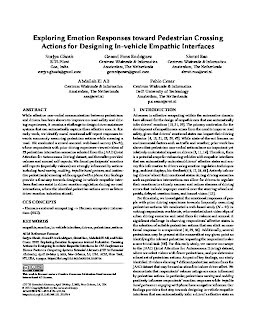2022-04-28
Exploring emotion responses toward pedestrian crossing actions for designing in-vehicle empathic interfaces
Publication
Publication
While affective non-verbal communication between pedestrians and drivers has been shown to improve on-road safety and driving experiences, it remains a challenge to design driver assistance systems that can automatically capture these affective cues. In this early work, we identify users' emotional self-report responses towards commonly occurring pedestrian actions while crossing a road. We conducted a crowd-sourced web-based survey (N=91), where respondents with prior driving experience viewed videos of 25 pedestrian interaction scenarios selected from the JAAD (Joint Attention for Autonomous Driving) dataset, and thereafter provided valence and arousal self-reports. We found participants' emotion self-reports (especially valence) are strongly influenced by actions including hand waving, nodding, impolite hand gestures, and inattentive pedestrian(s) crossing while engaged with a phone. Our findings provide a first step towards designing in-vehicle empathic interfaces that can assist in driver emotion regulation during on-road interactions, where the identified pedestrian actions serve as future driver emotion induction stimuli.
| Additional Metadata | |
|---|---|
| , , , , , | |
| doi.org/10.1145/3491101.3519764 | |
| 2022 CHI Conference on Human Factors in Computing Systems, CHI EA 2022 | |
| Organisation | Centrum Wiskunde & Informatica, Amsterdam (CWI), The Netherlands |
|
Ghosh, S., Pons Rodriguez, G., Rao, S., El Ali, A., & César Garcia, P. S. (2022). Exploring emotion responses toward pedestrian crossing actions for designing in-vehicle empathic interfaces. In Proceedings of the Conference on Human Factors in Computing Systems (pp. 1–6). doi:10.1145/3491101.3519764 |
|

